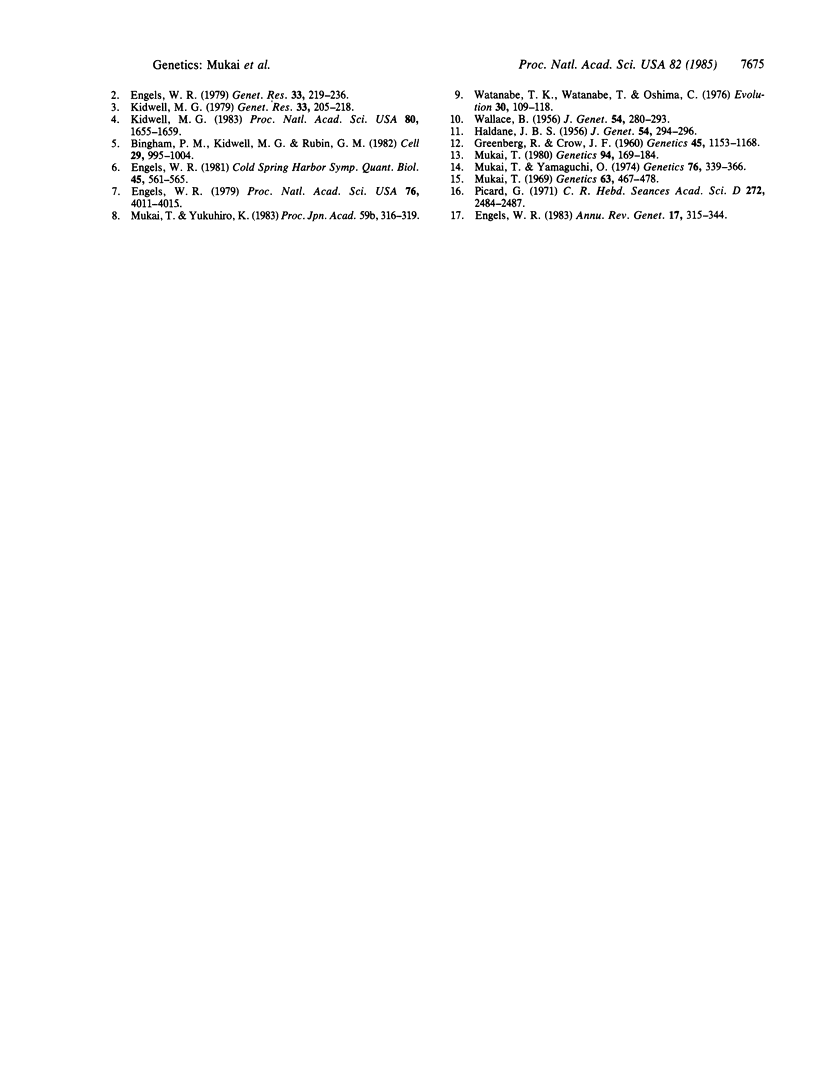Abstract
The lethal and detrimental loads per second chromosome rapidly increased from 1968 to 1970 in a local population of Drosophila melanogaster in Japan (lethal load, from about 0.16 to 0.38; detrimental load, from 0.125 to 0.231 [Watanabe, T. K., Watanabe, T. & Oshima, C. (1976) Evolution 30, 109-118]). When the homozygous loads were measured in 1983, the lethal load had decreased to approximately the original amount (0.19) but the detrimental load had stayed high (0.241). The rise and fall of the lethal load can be accounted for by a P-type element that invaded a population with M cytotype, producing a high mutation rate. The mutation rate fell back to the earlier value after the cytotype became P. That the detrimental load did not decrease can be explained by assuming a longer persistence for detrimental mutations in the population. Evidence for a P-type mutator factor is that the mutation rate of the wild-type chromosomes differs between the different cytoplasmic and chromosomal backgrounds, being lower in the background from which the chromosomes were taken.
Full text
PDF




Selected References
These references are in PubMed. This may not be the complete list of references from this article.
- Bingham P. M., Kidwell M. G., Rubin G. M. The molecular basis of P-M hybrid dysgenesis: the role of the P element, a P-strain-specific transposon family. Cell. 1982 Jul;29(3):995–1004. doi: 10.1016/0092-8674(82)90463-9. [DOI] [PubMed] [Google Scholar]
- Engels W. R. Extrachromosomal control of mutability in Drosophila melanogaster. Proc Natl Acad Sci U S A. 1979 Aug;76(8):4011–4015. doi: 10.1073/pnas.76.8.4011. [DOI] [PMC free article] [PubMed] [Google Scholar]
- Engels W. R. Hybrid dysgenesis in Drosophila and the Stochastic loss hypothesis. Cold Spring Harb Symp Quant Biol. 1981;45(Pt 2):561–565. doi: 10.1101/sqb.1981.045.01.072. [DOI] [PubMed] [Google Scholar]
- Engels W. R. The P family of transposable elements in Drosophila. Annu Rev Genet. 1983;17:315–344. doi: 10.1146/annurev.ge.17.120183.001531. [DOI] [PubMed] [Google Scholar]
- Greenberg R, Crow J F. A Comparison of the Effect of Lethal and Detrimental Chromosomes from Drosophila Populations. Genetics. 1960 Aug;45(8):1153–1168. doi: 10.1093/genetics/45.8.1153. [DOI] [PMC free article] [PubMed] [Google Scholar]
- Kidwell M. G. Evolution of hybrid dysgenesis determinants in Drosophila melanogaster. Proc Natl Acad Sci U S A. 1983 Mar;80(6):1655–1659. doi: 10.1073/pnas.80.6.1655. [DOI] [PMC free article] [PubMed] [Google Scholar]
- Kidwell M. G., Kidwell J. F., Sved J. A. Hybrid Dysgenesis in DROSOPHILA MELANOGASTER: A Syndrome of Aberrant Traits Including Mutation, Sterility and Male Recombination. Genetics. 1977 Aug;86(4):813–833. doi: 10.1093/genetics/86.4.813. [DOI] [PMC free article] [PubMed] [Google Scholar]
- Mukai T. The Genetic Structure of Natural Populations of DROSOPHILA MELANOGASTER. Xiv. Effects of the Incomplete Dominance of the IN(2LR)SM1 (Cy) Chromosome on the Estimates of Various Genetic Parameters. Genetics. 1980 Jan;94(1):169–184. doi: 10.1093/genetics/94.1.169. [DOI] [PMC free article] [PubMed] [Google Scholar]
- Mukai T. The genetic structure of natural populations of Drosophila melanogaster. 8. Natural selection on the degree of dominance of viability polygenes. Genetics. 1969 Oct;63(2):467–478. doi: 10.1093/genetics/63.2.467. [DOI] [PMC free article] [PubMed] [Google Scholar]
- Mukai T., Yamaguchi O. The genetic structure of natural populations of Drosophila melanogaster. XI. Genetic variability in a local population. Genetics. 1974 Feb;76(2):339–366. doi: 10.1093/genetics/76.2.339. [DOI] [PMC free article] [PubMed] [Google Scholar]


